Estimated reading time: 10 minutes
Growing fruit trees in buckets or a similar container is an excellent way to cultivate your own fruit, even in small spaces. Both columnar and dwarf fruit trees are easily grown in buckets, which means you can relocate them inside when the weather turns chilly. This allows you the ability to grow non-native breeds in nearly any climate.
Growing in buckets restricts the root space of plants and trees, creating dwarf varieties. Creating or purchasing genetic dwarf fruit trees or varieties of trees that were grown from dwarfing rootstock will typically give you the greatest chance of success when growing in a bucket.
Want to save this post for later? Click Here to Pin It on Pinterest!
What Is A Dwarf Fruit Tree?
There are two prime parts to nearly all fruit trees: the scion and the rootstock. The scion is the fruit top of the tree and the rootstock refers to the root system. The scion is grafted to the root system.
On dwarf fruit trees, the scion is first dwarfed and then compacted so it is packed tightly with the fruit spurs. Dwarf trees produce standard fruit even though it would be highly unusual for them to grow larger than six to eight feet tall.
The dwarfed rootstocks prompt the scion to grow far more compact and smaller than a standard tree – without really sacrificing any productivity. Nearly all deciduous fruit tree varieties are also available in a dwarf version.
Most dwarf fruit trees do not need more than eight feet in diameter of space to grow – many varieties require even less space to thrive. Putting a few fruit tree in a bucket on your back patio would definitely be possible.
Another check in the plus column for dwarf fruit trees involves their rate of maturity. Generally, dwarf trees bear crops about one to three years sooner than standard trees of the same variety.
Pruning Matters
Pruning helps keep fruit trees healthy, but it can also be used to help spark or control growth. In a typical orchard, fruit trees are pruned as part of their training in an effort to bolster production. Conventional fruit tree pruning techniques are designed to train a tree to spread wide and grow tall.
When growing fruit trees in buckets, such a sprawling tree simply would not work. Pruning more frequently will keep the trees small but not reduce crop yield – when done properly.
Apple tree varieties often have the most flexible rootstocks for dwarfing and are likely the best type of tree for a beginning pruner and fruit tree bucket container gardener.
Columnar And Dwarf Fruit Tree Growing Tips
- For best results, grow dwarf fruit trees (and columnar trees) in a bucket that is at least one foot deep and one foot wide. You must drill holes in the base of the bucket for water drainage.
- As the tree begins to produce fruit, you will likely need to anchor it to a post or stake for added support.
- The dwarf and columnar fruit trees must be placed where they can garner a minimum of six hours of sun per day.
- Ideally, a soil-based potting mix that is designed to slowly release nutrients should be used when planting fruit trees in buckets or containers.
- Use a high potash supplement as soon as blossoms appear through the middle of the fall. Mulching the soil to help it retain moisture throughout the summer months is also strongly recommended.
- Unlike when growing standard fruit trees, produce from bucket fruit trees can be picked year around instead of just at the end of the growing season.
- Both birds of all types and Japanese beetles will be drawn to the fruit trees. Place bird netting over the trees to help prevent the flying creatures from stealing your food. Treat the area around the trees and the fruit bearers themselves beginning in the early spring and continue throughout the growing season to keep these stealthy and destructive insects at bay. Sprinkling an equal parts mixture of salt and flour around the base of the trees is the best way I have found to deter (and kill) Japanese beetles.
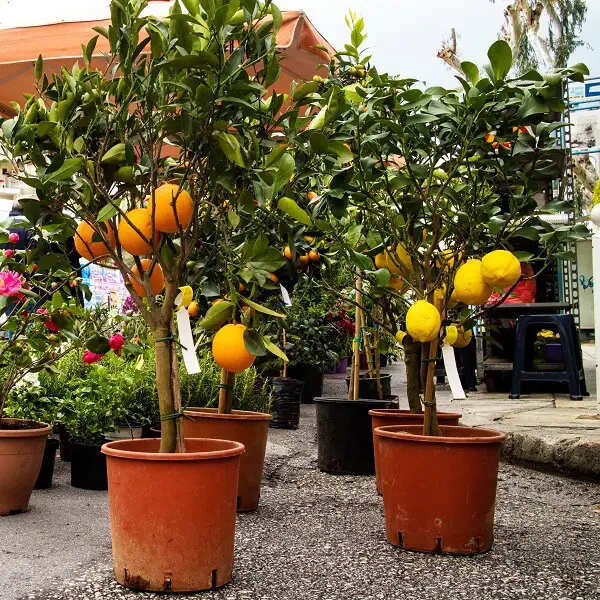
Columnar Or Pillar Trees
Fruit trees of this type range in height between a dwarf and a standard tree. Additionally, these trees grow in a narrow column or pillar shape, so they do not usually grow too top heavy for planting in containers.
Top 15 Fruit Trees To Grow In Buckets
1. Apricot Trees
Apricot trees can be grown in buckets so long as you also use rootstock. Apricot trees also require very little pruning when grown in buckets, which stands in stark contrast to most other kinds of fruit trees grown in small spaces.
Just be sure to bring your tree indoors where it’s warm if frost has been forecast for the night.
2. Avocado Trees
Avocado trees can be grown in buckets or containers, just keep in mind that the size of the resulting tree will be restricted based on the size of the bucket. Take note that avocados will mature on the tree, but you will need to pick them before they can ripen.
It’s also critically important to give avocado trees shade from the sun because their skins can sunburn easily.
3. Columnar or Dwarf Apple Trees
Columnar apple trees grow to reach about two feet wide and up to 10 feet tall when mature. These trees are a small variety of apple tree and not a dwarf version of an apple tree. This space-saving fruit bearer offers a yield that is often a little less than dwarf versions of apple trees.
Columnar apple trees should be planted at least in pairs for pollination purposes. Some popular columnar apple varieties include the Golden Sentinel (akin to Golden Delicious), the Northpole (similar to McIntosh), and the Scarlet Sentinel, which produces a greenish to yellow apple with a slight red hue.
Dwarf apple trees will cross-pollinate with either the same or a different variety of small stature apple trees. The best dwarf apple trees to grow for cooking apples include the Liberty, Gordon, and Sierra Beauty. The most popular raw eating and dessert apple varieties include the Pink Lady, Gala, Honeycrisps, Fuji, Cox, and Jonagold.
4. Dwarf Cherry Trees
Dwarf cherry trees are one of the few fruit-producing trees you could grow that prefer a shady area. Popular dwarf cherry breeds include Acid Cherry and Morello. Both varieties produce tart cherries.
Dwarf cherry trees fan out significantly as they grow, making against-the-wall or trellis growing a must for support purposes. All non-heirloom cherry tree varieties are self-pollinating.
5. Dwarf Nectarine Trees
Dwarf nectarine trees produce a sweet juicy full-size fruit. These trees typically grow about four to six feet tall. Dwarf nectarines are self-pollinating. Popular varieties of miniature nectarine trees include Garden Delight, Nectarina, Leprechaun, and Necta Zee.
6. Dwarf Orange Trees
Dwarf orange trees are sometimes considered among the easiest to grow and are highly recommended for beginner container gardeners. One of the most popular dwarf orange tree varieties is the Calamondin.
Unlike nearly all other varieties of citrus trees, it can easily keep producing while wintering indoors – or grow inside year round when given adequate light.
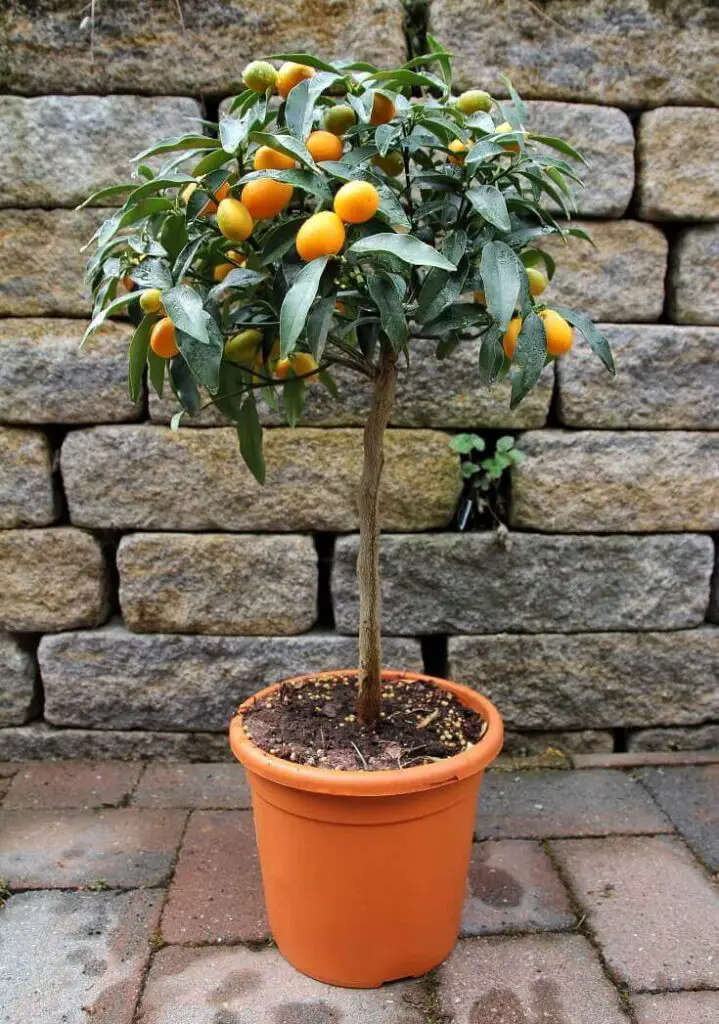
7. Dwarf Peach Trees
Dwarf peach trees often fan out like a cherry tree to expand their fruit producing ability without adding unnecessary height. These bucket fruit trees require little pruning but are susceptible to frost damage in the early spring.
For the most successful results, bring dwarf peach trees inside when the threat of frost is present, especially after blossoms appear. Even though these trees are self-fertile, cross-pollination can help bolster your harvest yield. Popular dwarf tree varieties include Reliance, Contender, and the Belle of Georgia.
8. Dwarf Pear Trees
Dwarf pear trees are easy to grow in a bucket due to their compact dimensions, but they are highly susceptible to late frosts. Miniature pear plants come in both fruit tree rootstock and bush versions. Some of the most popular dwarf pear tree varieties include Moonglow, Doyenne du Comice, and Bartlett.
9. Fig Trees
Fig grows well in buckets as well, as long as it is pruned regularly to keep the tree no taller than 15 inches high. Popular varieties of container fig trees include Black Genora, Brown Turkey, White Genoa, and Preston Prolific.
10. Meyer Lemon Trees
Lemon trees are a great choice to grow in buckets because the trees themselves only need to grow two feet tall before they begin to yield fruit. Meyer lemon trees, in particular, are unique because they create a fruit that is a combination of mandarin orange and lemon.
The result is a lemon that has a distinctively sweeter taste, and that is a great addition to most teas. You can grow Meyer lemon trees outside during the summer, but be sure to bring them into a warm room or greenhouse during the cold winter months.
11. Peach Columnar Trees
Peach columnar trees generally grow only five feet wide. Branches should be pruned back to one foot long during the early spring to avoid unwanted bushiness. These trees are self-pollinating and do not need to be planted in pairs. Popular peach columnar varieties include SummerFest, Crimson Rocket, and Sweet-N-Up.
12. Pineapple Guava Trees
Pineapple Guava trees are beautiful and produce a delicious fruit – even the white petals around the scarlet stamens are edible. Pineapple guava trees must be pruned in either the late winter or the early days of spring.
In order to produce fruit, these trees must be exposed to a minimum of 100 hours of below 45-degree temperatures. Once picked, the produce from this fruit tree will continue to ripen. Read the label of the purchased trees carefully as some varieties require cross-pollination.
13. Plum Trees
Plum trees can provide you with lots of fruit with little care and maintenance in return. They require very little pruning and as long as you give them plenty of water with exposure to the sun, they should grow quickly due to the fact that they are self-fertile.
The biggest downside to plum trees is that they tend to overproduce in their first year and then underproduce in their second year.
14. Pomegranate Dwarf Trees
Pomegranate dwarf trees grow only up to six feet tall and do not require cross pollination. The grenadine flavored fruit tends to grow more even sweeter after it is picked. The most readily available pomegranate dwarf tree variety is the Red Silk.
15. Star Fruit Varieties
Star Fruit varieties all grow well in buckets or containers. Because the root space is compacted and prevent the tree from growing very tall, they are far more manageable to prune.
Pruning back the star fruit trees both in the winter and early spring will help keep both their height and width in check. Popular star fruit tree varieties include Kari, Fwang Tung, Arkin, and Sri Kembangan.
Conclusion
Starting a robust fruit grove even in a small space is feasible – as long as you regularly attend to the trees. Throughout the growing season, check the soil for both nutrient content and pH balance to prevent the bucket fruit trees from failing due to poor quality soil.
Like this post? Don't forget to Pin It On Pinterest!
You May Also Like:

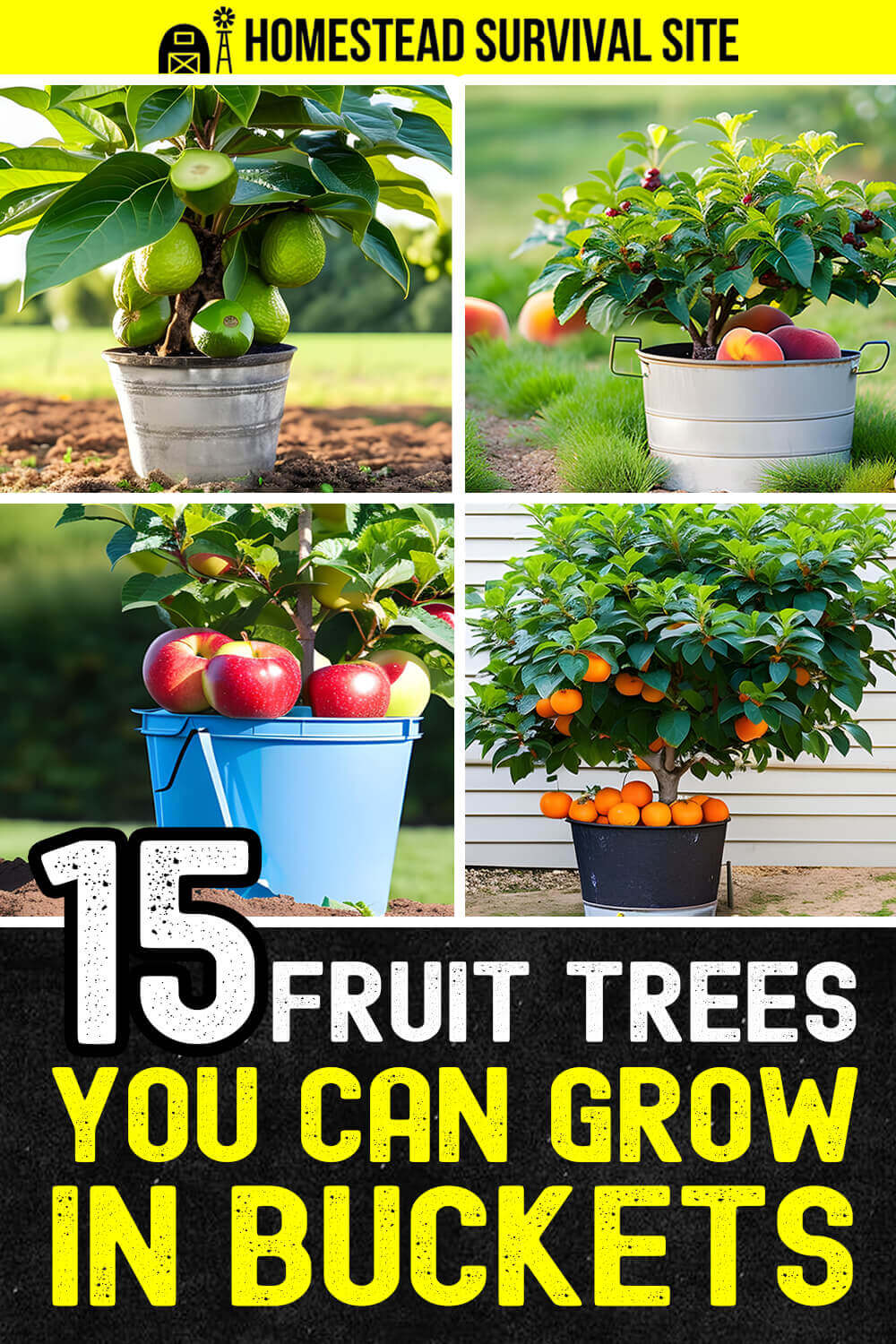


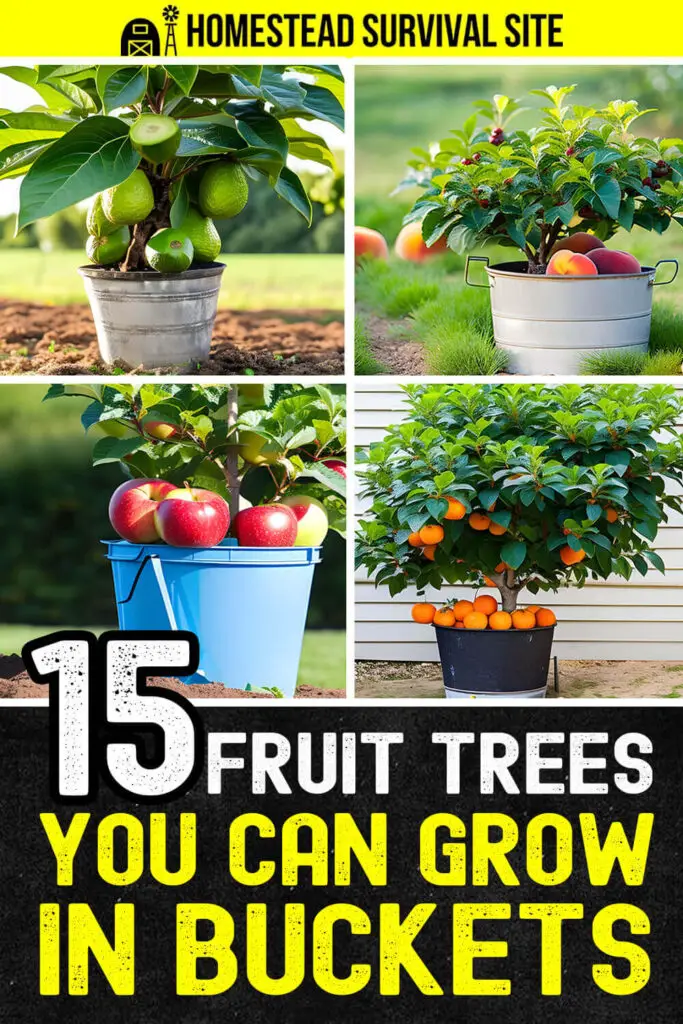


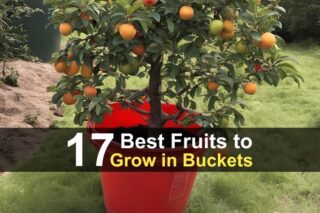


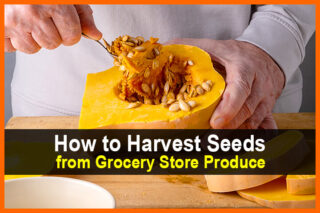


Where is a good place to purchase these trees? I also would like to grow some lemon trees and possibly a couple olive trees. I wish the world wasn’t so evil. There’s plenty for everyone if humans could just get alone.
What do you do with the trees in winter? will the roots freeze and kill the tree?
I started a lemon tree from a seed about a year ago. It’s short and bushy but no flowers. Will I ever get flowers?
Citrus trees take between 3-5 years to produce fruit. Hang in there, patience is not always easy. You’ll have so many lemons, you will have to share with the neighbors
If I start a lemon tree from seed will it produce lemons , or any Rotherham fruit tree,, oranges, apple or thers
Fruit trees grown in buckets let’s you take them with you if you must move. I lost an entire greenhouse by not anticipating having to move. Gardens grown in buckets aren’t exactly Bug Out gear, but a river that’s going to flood does motivate you.
Are there any suggestions for what may be successfully grafted onto old (but live) tea tree ( of drinking tea variety) stumps. Medicinal type trees such as Java tea or fruit. Tropical highlands (spring like) climate. Any advice really appreciated. Thanks.